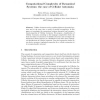Free Online Productivity Tools
i2Speak
i2Symbol
i2OCR
iTex2Img
iWeb2Print
iWeb2Shot
i2Type
iPdf2Split
iPdf2Merge
i2Bopomofo
i2Arabic
i2Style
i2Image
i2PDF
iLatex2Rtf
Sci2ools
IANDC
2008
2008
Computational complexity of dynamical systems: The case of cellular automata
Abstract. Cellular Automata can be considered discrete dynamical systems and at the same time a model of parallel computation. In this paper we investigate the connections between dynamical and computational properties of Cellular Automata. We propose a classification of Cellular Automata according to the language complexities which rise from the basins of attraction of subshift attractors and investigate the intersection classes between our classification and other three topological classifications of Cellular Automata. From the intersection classes we can derive necessary topological properties for a cellular automaton to be computationally universal.
| Added | 10 Dec 2010 |
| Updated | 10 Dec 2010 |
| Type | Journal |
| Year | 2008 |
| Where | IANDC |
| Authors | Pietro di Lena, Luciano Margara |
Comments (0)

